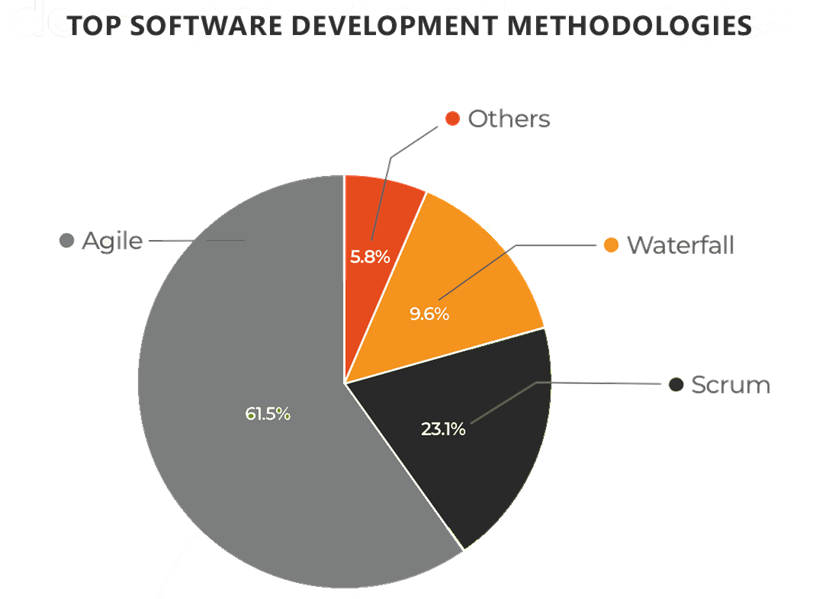For more information on your charming neighborhood CSW Solutions, visit us at our home or subscribe to our newsletter! We also do that social networking thing at: Twitter, Facebook, Linkedin, and Instagram! Check out our #funfactfridays
7 Top Software Development Methodologies: An Insider Guide
The ever-evolving world of technology has given rise to a vast array of software development methodologies. With the sheer number of methodologies available, it can be difficult for businesses to know which one best fits their needs. In this blog post, we will explore the most popular software development methodologies used by businesses today, examine their strengths and weaknesses, and try to provide insight on how it could be more beneficial for your teams or businesses.

Agile
Agile is a lightweight and flexible approach to software development. While agile can be applied to virtually any software development methodology, it was originally developed at a time when the waterfall methodology was prevalent. So, in many ways, agile is an alternative to the waterfall methodology. Waterfall tends to take a top-down approach that pinpoints specific deliverables and deadlines from the beginning of the project. It's a methodical approach that takes into account each step in the process, beginning with analysis and ending with deployment. And while this kind of process can work well for projects with clearly defined deliverables and end dates, it can be incredibly inefficient for other projects that don't have such clear goals.
Like waterfall, agile is comprised of several phases including initial planning, implementation and delivery, testing, release and maintenance. However, unlike waterfall, it doesn't focus on deadlines or deliverables that can easily cause teams to rush their products without fully considering them.
Scrum
Scrum is an agile methodology that emphasizes teamwork, collaboration, and constant communication. Scrum teams work in short sprints to deliver features and updates on a regular basis. This approach helps to ensure that projects stay on track and that team members are always aware of the project’s progress. However, scrum can be very demanding, and team members may find themselves feeling overwhelmed by the constant need to communicate and collaborate.
Scrum delivery is what most software development companies utilize. It is a methodology that has been around for decades and is one of the most preferred and most successful methodologies adopted by businesses today.
The Scrum methodology consists of:
Sprint - A set time period where the team will focus on a specific segment or goal of the overall project. This period is typically 2-4 weeks.
A Daily scrum - A 15-30 minute meeting held daily where the team meets to touch base and communicate any roadblocks. At this time both parties provide a brief status update at a high level.
A Sprint planning meeting - A meeting that occurs at the beginning of each sprint, where the team will discuss the goals for that sprint and come up with tasks to achieve it.
A Sprint review meeting - A meeting that occurs at the end of each sprint where it's main purpose is to present what was accomplished within the sprint.
Waterfall
The waterfall methodology is a more traditional approach to software development. In this approach, project requirements are defined up front, and development is completed in a linear fashion. This methodology is more predictable and can be less chaotic than agile approaches. However, waterfall can also be inflexible, and if requirements change during the development process, it can be difficult to make changes without starting the project from scratch.
This methodology of software development is an incremental, disciplined, and well-defined approach. Each phase of the waterfall's methodology must be completed before proceeding to the next phase.
The typical steps of this methodology are:
Requirement gathering: The project requirements are gathered from the top down, according to the project scope, risks, involved stakeholders and so on. This is not just a question of collecting all of the information relating to systems and users; it's also a matter of understanding the requirements and relationships among them.
Requirement analysis: An analysis is made of all the requirements gathered in Step 1. Here, the requirements are analyzed both from procedural and technical perspectives. System requirements are translated into operational requirements which are then analyzed by systems analysts for further elaboration and refinement. The output of this activity is a greater degree of understanding about the current state and future state expectations for both hardware and software.
Lean
The Lean methodology was originally developed from the Toyota Production System, which revolutionized the manufacture of physical goods in the 1950s, '60s, and beyond. Lean has been adopted by many organizations, including government agencies, hospitals and financial companies to improve their business processes. As it relates to software development, it simply means building the least amount of product to solve the problem, in the shortest amount of time, and at the lowest amount of cost.
Lean methodology is a subset of agile methodology that emphasizes efficiency and minimization of waste. Lean teams work in short iterations to deliver value to the customer as quickly as possible. This approach helps businesses to avoid developing unnecessary features, and to focus on creating the most important features first. However, lean methodology can be difficult to implement properly, and if not done correctly, can lead to projects being delivered late.
Kanban
Kanban is a lean methodology that emphasizes visualization of work and workflow. Kanban teams use Kanban boards to track the progress of their projects and to identify which tasks need to be completed next. This approach helps to ensure that projects are always moving forward and that team members know what needs to be done at all times. However, Kanban can be difficult to implement properly, and if not done correctly, can lead to projects becoming bogged down.
Kanban methodology is a software development strategy that also came from Toyota but in the 1930s, and practices have since been adopted by many software development companies. Kanban is Japanese for "visual signal".

The Kanban methodology is an efficient way to organize tasks in a software development project as well as to communicate project status with the people involved in the project. This method also makes sure we don't forget about any of the tasks or get overwhelmed by tasks we need to complete and therefore prevents us from neglecting important tasks that need our attention.
The steps of the Kanban methodology are:
- Assign each task a unique ID and hand them out to individuals working on the project.
- Next, lay out these tasks on a large piece of paper so you can easily view work as it comes in.
- Put all the tasks for all of your developers into one column and all of your designers into another column, then any other job titles into two more columns.
Rapid Application Development (RAD)
In application development, rapid application development (RAD) is a software development methodology that relies on the immediate construction of working software. RAD promotes a user-centered approach to software development that aims to deliver applications that are short-term and high-quality at the same time.
The best approach for RAD is also one of the oldest known techniques for programming: writing code to directly solve a problem. This may be called the waterfall model, or sequential design. The sequential development models are designed to reduce entropy, which occurs when there exists no system in a particular initial state has a tendency to move towards widespread disorder.
RAD is not a single technique but rather a collection of different techniques that allow end users to quickly and easily create modifications and new applications without the help of programmers or complicated design methods. The goal of this process is to reach a predictable state, where any future changes will have only limited impact on the overall system's behavior.
DevOps
The beginning of the DevOps movement began in 2007, when Patrick Debois organized a virtual meeting to discuss "how to foster communication, collaboration, and integration between software developers who are responsible for the software product (the development team) and the IT operations teams that are responsible for supporting it once deployed into production."

One of the most popular methodologies currently being practiced in the software development industry is DevOps. DevOps is a methodology that emphasizes communication, collaboration and integration between software developers and information technology operations professionals.
The two disciplines within DevOps namely, development and operations, share the same goal of delivering any application that meets the business requirements at the most optimal and scalable way. Developers work closely with the operations team to solve problems or issues that affect the production environment. It aims to improve software quality, responsiveness to change requests, and the ability to incorporate changes more rapidly. It is a team-based approach in software development where the development, operations and testing teams are co-located and are aligned to release software in sprints.
The end-goal of DevOps is to develop and deliver high quality code in shorter cycles. This is achieved by a collaborative team that works closely with an agile methodology.
Which software methodology is right for you?
Each of these methodologies have their own advantages and disadvantages, and which one is best depends on the specific project and team. Other less common methodologies include extreme programming, feature-driven development, and spiral development. From traditional waterfall development to iterative and incremental approaches, there are now countless ways to design and deliver high-quality software.
But deciding which methodology is best suited for a given project can be difficult. No matter which methodology is chosen, it is important to be aware of the potential trade-offs that come along with each one. By understanding the strengths and weaknesses of each approach, developers can make informed decisions when selecting the right methodology for their projects. Ultimately, the best methodology for any project will depend on the team's skills and experience, the customer's needs, and the scope of the project. With careful consideration and planning, you can ensure that your project is successful and that your software development process is as efficient as possible.
If you are interested in learning more about which software development methodology sounds best for you in the new year, reach out to us here or on social media! We're always interested in new ideas and working together to bring innovation and success to everyone we work with, here and in the cloud!

